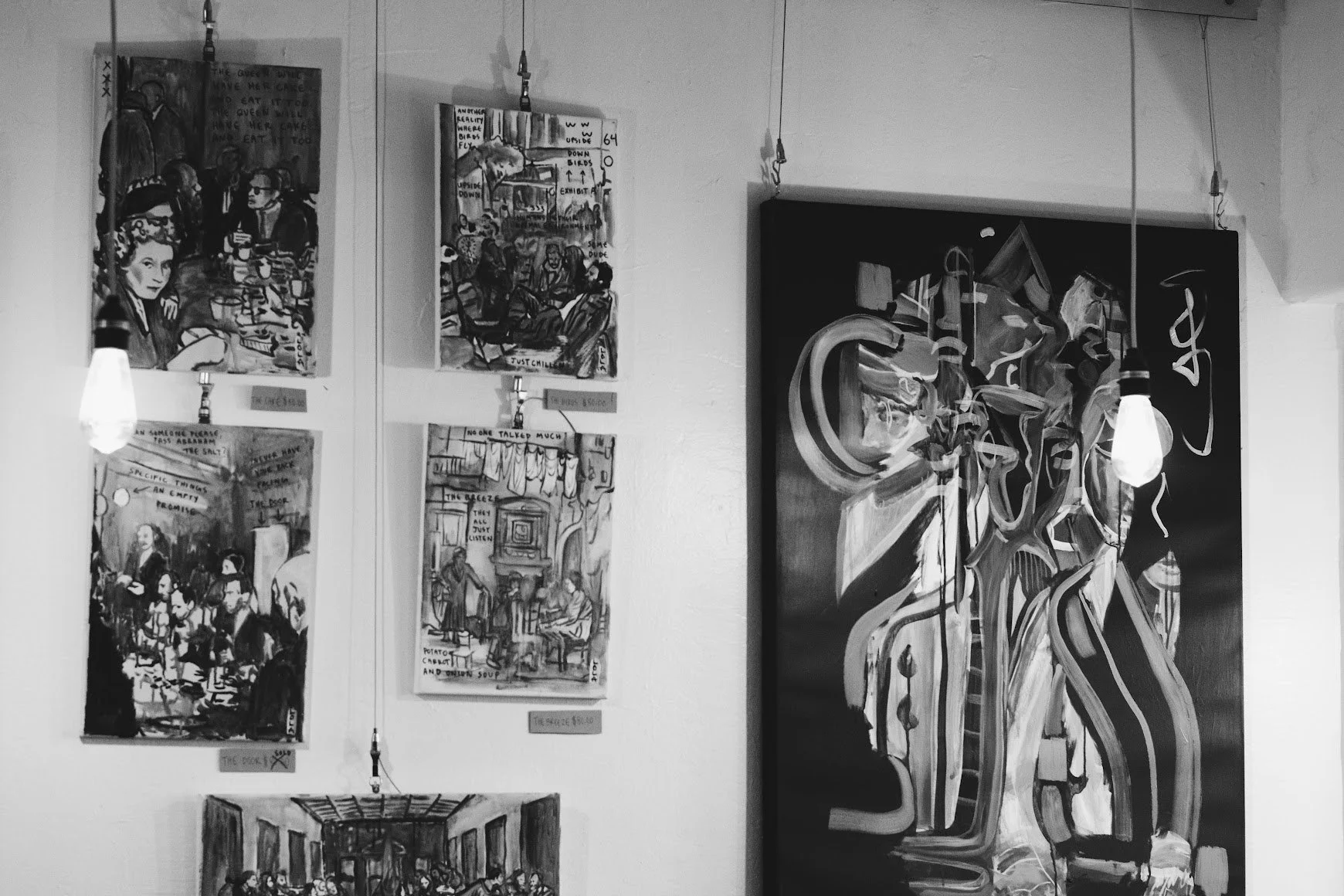Scene Report | June 14th, 2022
Lola-vision
Lola’s world is a garden grown wild and untamed, mixing the sacred and profane.
by Jade Oates
Over the past few years, Lola’s drawings on Naked Lounge signs have imbued the café with a particular Lola-vision. With an abstract storm of faces and hands and phrases, she suggests, on sandwich board after sandwich board, that the cacophony of so many voices in conversation in the café are not interrupting and contradicting, but rather have an order of their own, all these various conversations joining together to create a larger operatic performance. Come be a part of it, the hanging black board urges. And often you do. Order a cappuccino and strike up a conversation with the fellow at the next table. It’s how we all met each other once upon a time, and how we continue to meet still. Did Lola make it happen? Or has she merely drawn our gaze to a rhythm already at work?
Now, with Naked Lounge literally filled with her art, Lola defines the space. The surreal crowd of faces ought to always hang there on those canvas curtains. The faces and their conversation give color to the fleeting spirit we come downtown for. The poetic correspondences between passing sights and sounds reveal themselves now and then to be part of a larger performance. And it feels as if Lola really had built Naked Lounge brick by brick and introduced us all to each other one cappuccino at a time.
This Lola-vision emerges in precious moments only to recede again like a tide: Between the wonderfully realized canvases of so many faces are much cheaper, less creative pieces (must I call them pieces?) like three framed pennies, which are not art at all but a mocking demonstration of Warholian dominance. Lola smirks: I can make you look at this.
Why can she make us look at this? Things like framed pennies, or a sock, or a box of dirt? It’s not, thank God, because we’re all living in a nihilist hell of our own making. No, we still care about beauty, and Lola has earned our attention with truly beautiful paintings. She has certainly developed a style–one of wild brush strokes and vibrant colors, adding up to a dancing and pulsing quality that might seem incongruous with the stoic barista at the counter but is quite certainly the child in spitting image of its mother, the ecstatic ballerina still twirling in the kitchen at 3am. Lola creates wildly and compulsively. She possesses the rare and enviable childlike ability to create as a way of thinking. Therefore this art show is the wildness of her mind laid bare, not really sorted out into theme or style. And still there is sometimes a pleasing logic to the arrangement of things: so many pairs–sister works–achieve a satisfying symmetry. Lola’s world is a garden grown wild and untamed, mixing the sacred and profane. Lola herself appears unceremonious and unassuming in her Honda baseball cap and red drawstring shorts.
To understand the more profane framed objects in a better light, let us humor the idea that Lola is really discovering art for the first time, as if no one had ever painted before, as far as she’s concerned. She is discovering the fact of the symbol and begins to work with it in a basic and primal way. She takes an object, a sock for example, and puts it in a frame, and now this is not a sock anymore but a symbol of Sock, suggesting not this particular sock but all socks and everything that a sock implies. This is still an ultimately useless object and not real art: This is not art, because a symbol without context is only an object without meaning. To frame it then and sell it as art is parallel with Yves Klein selling canvases of blue. It is not art, but a souvenir from the artist's workshop. It is not yet an idea, it is only one of the artist's materials for idea-making. Pieces like “Joe’s Cigarette” and “The Missing Sock” are not art pieces but a cynical dadaist currency–Lolacoin you can collect in the hope that she does happen to win art history’s lottery.
Still, the leap Lola makes from this discovery of The Symbolic is a huge one. She shows us the development of art and magic within the span of a few seconds. From framing the object in a Warholian way, and making it hyperreal, she then shifts to a discovery of how symbols interact. In so many canvases, symbols begin to arrange themselves, sometimes chaotically and wildly, and other times in mandala-like patterns. Suddenly, brilliantly Lola begins to use the symbolic to represent ideas, even worlds. In this way, we do get to watch Lola-vision emerge in real time.
Some canvases give the sense that Lola has confused canvas for notebook. Is this a painting for a show or a journal entry? Certain basic truisms included in her paintings reflect an insta-famous illustrator culture, but are clearly beneath Lola’s full potential as an artist. What is amazing about Lola is the vastness of her world. Whether I think all of it ought to be displayed or not, there was no question whether she could fill the space. I might consider some of the plants weeds, but in the wild and untamed garden of Lola, the fact of fertility is undeniable.


